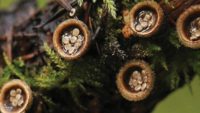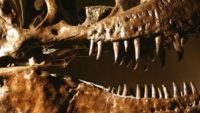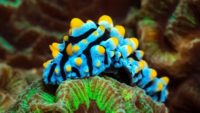By Ken Ham How old is the universe? Well, we can know for sure, but I’ll get to that in a moment. But from a secular standpoint, the answer to that question depends on which study you read—because they can’t agree! Here’s what I mean. One study, of which the popular summary was published July 15, 2020, claims the universe is 13.8 billion years old. They based this age on “the best image of the infant universe.” So they used what they call the “oldest light” to determine the age of the universe—and they’re confident it’s 13.8 billion years old. [More]
Once again, results are better when aquaculture imitates the natural life cycle of Atlantic salmon.1,2 In other words, the closer fish farmers get to imitating God’s natural program for anadromous fish life cycles, the healthier it is for the fish being farmed.3 This is no surprise for biblical creationists, but this has been a new learning experience for secular scientists. More… …read more Source: icr.org
Did Modigliani’s striking lizard—a variety of Agamidae “dragon lizard”—go extinct, or has it just been hiding in Indonesia for 129 years? Recently, this sneaky reptile was discovered lying dead near a volcanic caldera in part of North Sumatra (in Indonesia). This proves that the nose-horned striking lizard has been hiding, sheltering in its place, unseen (by people) for more than a century. Yet we now … More… …read more Source: icr.org
Did people believe in apemen before Darwin? …read more Source: creation.com
By Dr. Gordon Wilson The forest is full of unseen wonders. Consider just one common type of fungus on the forest floor. …read more Source: AIG Daily
Using computer simulations, a team of researchers has concluded the planet Venus could still be geologically active.1,2 The scientists used computers to simulate the formation of coronae—ring-shaped, volcanic structures on the planet’s surface. By comparing the results of their simulations to images taken by spacecraft, they concluded that at least 37 coronae have been recently active.2 La… More… …read more Source: icr.org
By Ken Ham Did small mammals scavenge dinosaur bones? A new study looked at tiny bite marks on the bones of massive long-necked dinosaurs, the sauropods, and concluded small scavenging mammals gnawed away at the bones. This makes sense within the context of the global flood. Eventually, rising floodwaters buried those remains, drowning and perhaps burying the scavengers along with them. As the floodwaters rose, dinosaurs and other creatures were drowned. Some were rapidly buried by the sediments carried in the water. Others drowned, and their decaying carcasses washed up on shore, where scavengers nibbled on a free meal. Eventually, [More]
What effect did long-lived men having children have on human genetic diversity? …read more Source: creation.com
By Melinda Christian The words “slug” and “festive display of color” don’t usually come to mind at the same time. Fun facts about nudibranchs or sea slugs. …read more Source: AIG Daily
If you were standing in a field of tomatoes, you might be surprised to know that the soil underneath your feet is teeming with electrical signals being sent among plants as described in a new research study.1 These results continue to expand the startling complexity of plant adaptation and point directly to an Omnipotent Creator who engineered it all. In 2013, a study was published showing that plants signaled each other… More… …read more Source: icr.org
By William Worraker The biblical and scientific arguments for a pre-Flood vapour canopy do not support the theory. …read more Source: AIG Daily
Recent research from the Okinawa Institute of Science and Technology Graduate University (OIST) continues to highlight how evolutionary theory influenced scientists to foolishly conclude that DNA in organisms not used to code for proteins (termed “non-coding” DNA) is useless “junk.” A press release highlighted an OIST scientist’s paper published in Nature Communications that identified a specific genomic reg… More… …read more Source: icr.org
Both amateur and professional stargazers have an opportunity to see a little more of God’s glory revealed in the heavens1 next week. The Perseid meteor shower is probably the best of all the annual meteor showers, and it is scheduled to put on a “peak performance” in the early morning hours of Monday through Wednesday, August 12-13.2 Meteor showers are caused by comets. When comets approach t… More… …read more Source: icr.org
Are scientists always objective? Do they always interpret the evidence with an open mind? Some time ago I experienced first-hand how a scientist’s beliefs affect the way he looks at the evidence. Whilst a geology student at university, I needed to identify a fossil. After consulting the Atlas of Invertebrate Macrofossils 1 I had tentatively identified it as a belemnite2 of the genus Hibolites. However, paleontology was not my specialty so I sought advice from an expert. …read more Source: creation.com
A new study published in Nature Ecology & Evolution has claimed that flowering plants, the most common type of plant on Earth, first appeared in small numbers in rocks of the Early Cretaceous. Fossils indicate that these plants became extremely abundant in rocks of the post-Cretaceous (or Cenozoic) after the dinosaurs disappeared in the rock record.1 However, creation scientists interpret these findings much differently. W… More… …read more Source: icr.org
New genetic evidence shows that humans may share DNA with super-archaic humans. …read more Source: creation.com
Did the physical mechanisms that operated during the Flood generate too much heat for Noah and the Ark to survive? …read more Source: creation.com
Vance Nelson’s latest book is impressive and like his previous works, contains a lot of original research accompanied with really beautiful pictures. A lot of time has gone into research and his photographic efforts. The book is written in an engaging and non-technical manner, and Vance took care to define his terms for lay readers. Summary: . …read more Source: creation.com
Evolutionary timeframes date the moon at about 4.5 billion years, with the lunar volcanism that produced the large, prominent and nearly circular, dark “seas” (or maria, as they are called) starting soon after that. The volcanism is mooted to have ended about three billion years ago. But researchers studying recent images of the far side of the moon, taken from the Japanese SELENE (Kaguya) lunar satellite, report dark “seas” of volcanic rock they say are “only” 2.5 billion years old, “much younger” than formerly presumed.1,2 That’s because there are fewer craters (blasted by meteors) on the smooth dark surfaces than [More]
In America, the month of July is accompanied by fireworks, even in the heavens.1 However, July is also a time when certain glow-in-the-dark animals—creatures of the sky and sea—shine forth their own “night lights.”2 Two such examples are noted here: lightning bugs in the air, and jellyfish in the sea. Both of these animals are bioluminescent. These creatures produce biochemical oxidatio… More… …read more Source: icr.org
The latter days of July are very busy for many pollinators.1 These include birds, bees, butterflies, moths, beetles, flies, bats, and more.1-3 Pollination is essential to a healthy planet. Humans, wildlife, and agriculture benefit enormously from the supposedly simple practice of airborne animals transferring pollen from one flowering plant to another.1,2 More… …read more Source: icr.org
Pagan and philosophical cosmogonies, and the major reinterpretations of Genesis 1 they have led to-gap theory, progressive creation, and theistic evolution-violate Genesis’ teaching about Creation, Rest and providence. …read more Source: creation.com
Dog genetics present a huge problem for evolution. Despite many centuries of breeding producing many varieties, from Chihuahuas to Great Danes, dogs are still dogs. …read more Source: creation.com
Recent research on the flying behavior of Alaskan alcids shows how Earth has two kinds of fluid-filled “oceans”, the liquid ocean of sea-water and the gaseous “ocean” of air.1-3 (Alcids are auk-like birds, such as murres, guillemots, and puffins.) The study reveals that these birds, from the Alcidae family which includes puffins, murres and their relatives, produ… More… …read more Source: icr.org
Most people might be surprised to learn that the human genome has not been fully sequenced. Gaps still remain that have not yet been bridged because of the nature of the DNA sequence coupled with past limitations on DNA sequencing technology. Nevertheless, a study has just been published using new and improved technologies that have allowed for the first complete sequence of a human chromosome.1 Sequencing the complete h… More… …read more Source: icr.org
For centuries, mercury has been used in thermometers for reading our body temperatures, but now we measure mercury levels to see if seafood is safe to eat.1-4 If you are hungry for fish, maybe trout would be a good choice.1 Nearly half of all gamefish in freshwater lakes, streams and rivers in the Chesapeake Bay watershed may be unsafe to eat because of high levels of mercury… More… …read more Source: icr.org
By Dr. Danny R. Faulkner Greek philosopher Heraclitus was one of the first promoters of an eternal universe, which found its way into Christian theology. The Bible tells a different story. …read more Source: AIG Daily













































